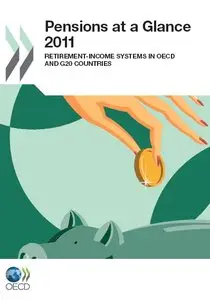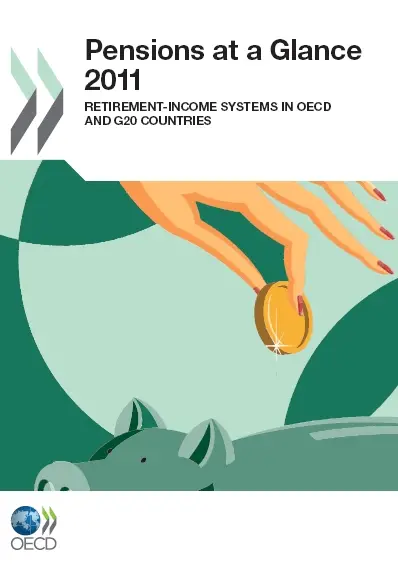Pensions at a Glance 2011: Retirement-income Systems in OECD and G20 Countries
OECD | 17 Mar 2011 | ISBN: 9264095233 | 350 pages | PDF/djvu | 3 MB
OECD | 17 Mar 2011 | ISBN: 9264095233 | 350 pages | PDF/djvu | 3 MB
The theme of this fourth edition of Pensions at a Glance is pensions, retirement and life expectancy. Many countries have increased pension ages in the face of population ageing and longer lives. Some have introduced an automatic link between pensions and life expectancy. Improvements to the incentives to work rather than retire are also a common part of recent pension-reform packages. However, ensuring that there are enough jobs for older workers remains a challenge.
This edition updates information on the key features of pension provision in OECD countries and provides projections of retirement income for today’s workers. It offers an expanded range of 34 indicators, covering the design of national retirement-income provision, pension entitlements, incomes of older people, the finances of pension systems, the demographic and economic context in which pension systems operate and private pensions.
PDF: pdf MegaUp Mirror • | • pdf ES Download
DJVU: djvu MegaUp Mirror • | • djvu ES Download
An in-depth look at these important policy issues is provided by five special chapters on: pension ages, retirement behaviour, pension incentives to retire, the demand for older workers and linking pensions to life expectancy.
More countries are analysed than in previous editions, including four new members of the OECD: Chile, Estonia, Israel and Slovenia. Where possible, data are also provided for the other major economies in the G20: Argentina, Brazil, China, India, Indonesia, Russia, Saudi Arabia and South Africa. Along with data on the European Union’s 27 member states, this brings to 43 the number of economies covered in the report.
Table of Contents
Editorial – Three Solutions to the Pensions Paradox
ISO Country Codes
Executive Summary
Part I. Policy Issues: Pensions, Retirement and Life Expectancy
Chapter 1. Pensionable Age and Life Expectancy, 1950-2050
1.1. Defining “pensionable age”
1.2. Trends in pensionable ages over a century
1.3. Expected duration of retirement: Life expectancy at pensionable age
1.4. Conclusions and policy implications
Notes
References
Chapter 2. Trends in Retirement and in Working at Older Ages.
2.1. Older workers: Labour-market participation
2.2. Retirement and labour-market exit.
2.3. Pathways into retirement
2.4. Fiscal imperatives and retirement in the future
2.5. Summary and conclusions
Notes
References
Chapter 3. Pensions Incentives to Retire
3.1. Measuring pension incentives to retire
3.2. Incentives matter
3.3. Changes in pension wealth from working longer
3.4. Individual earnings and changes in pension wealth
3.5. The role of taxes: Changes in net pension wealth from working longer
3.6. Adding a dimension to the analysis: Levels of pension wealth
3.7. Summary of the results for age 60-64
3.8. Policy implications.
Notes
References
Chapter 4. Helping Older Workers Find and Retain Jobs
4.1. A greyer workforce
4.2. Ageism.
4.3. Labour costs and older workers
4.4. Labour-market regulation.
4.5. Skills and training
4.6. Working conditions
4.7. Help in finding jobs
4.8. Jobs for younger and older workers
4.9. Policy conclusions
Notes
References
Chapter 5. Linking Pensions to Life Expectancy.
5.1. Life expectancy and recent pension reforms.
5.2. How uncertain is life expectancy?
5.3. Two benchmark pension plans
5.4. Pension entitlements and uncertain life expectancy
5.5. An indicator of automatic life-expectancy links in pension systems
5.6. The impact of taxes
5.7. The impact of individual earnings
5.8. Living longer, working longer?.
5.9. Conclusions and policy implications
Notes
References
Part II. Pension-policy Indicators
Chapter 1. Design of Pension Systems
Architecture of national pension systems
Basic, targeted and minimum pensions
Income-replacement pensions
Normal, early and late retirement
Chapter 2. Pension Entitlements
Methodology and assumptions
Gross pension replacement rates
Gross pension replacement rates: Public and private schemes
Tax treatment of pensions and pensioners
Net pension replacement rates
Net pension replacement rates: Public and private schemes
Pension replacement rates: Couples
Investment risk and private pensions
Gross pension wealth
Net pension wealth
Progressivity of pension benefit formulae
Pension-earnings link
Weighted averages: Pension levels and pension wealth
Retirement-income package
Chapter 3. Incomes and Poverty of Older People
Incomes of older people
Old-age income poverty
Chapter 4. Finances of Retirement-income Systems.
Contributions
Public expenditure on pensions
Pension-benefit expenditures: Public and private
Long-term projections of public pension expenditure.
Chapter 5. Demographic and Economic Context
Fertility
Life expectancy
Old-age support ratio
Earnings: Averages and distribution
Chapter 6. Private Pensions and Public Pension Reserves
Coverage of private pensions
Institutional structure of private pension plans
The pension gap.
Assets in pension funds and public pension reserve funds
Asset allocation of pension funds and public pension reserve funds
Investment performance of pension funds and public pension reserve funds 2
Pension fund operating costs and fees
DB funding ratios
Part III. Country Profiles
with TOC BookMarkLinks
PDF: pdf MegaUp Mirror • | • pdf ES Download
DJVU: djvu MegaUp Mirror • | • djvu ES Download
More : You find here



